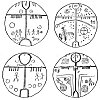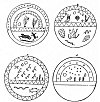
Sacred Texts Earth Mysteries Index Previous Next

IN Picture-Writing of the American Indians, Garrick Mallery has collected a delightful group of Tartar and Mongol magic drum tops, over which a little time will not be wasted just here. These drums were used--are used--by various Tartar and Mongol tribes in religious ceremonies, and their shamans believe that the sound of one design or figure painted on the stretched skin differs essentially from that of another pattern painted, and that therefore, one drum sounded may kill or torment, while
another may heal. Many of these designs are little world-pictures purely.

Click to enlarge
FIGURE 80. Painted Tartar and Mongol drums.
(From Picture-Writing of the America, Indians; Garrick Mallery, 1894, p. 515.)
The upper left-hand design in Fig. 80, for instance, suggests at first glance not only a two-storied division of heaven and Earth, but a World Mountain and a World Tree. According to Mallery, the two circles with inner dots above the cross-bar represent the Moon and Sun.
[paragraph continues] Two shamans or priests of magic are pictured on the left, and with them a wild goat and five serpents. On the right are three shamans and a deer.
The upper right-hand design (b) had the same four-quarter division, with a face indicated in the top loop of the axis or tree, and with the upper heavens spangled with stars, suns and moons. Below the cross-bar are a rainbow with stars beneath it, and, above the rainbow, two "heavenly maidens." This magic drum design represents "the bringing of the horse to sacrifice."
The lower left-hand design (c), says Mallery, "is the external delineation of a head without eyes and nose." The shamans who owned this drum said that the circles, two above the cross-bar and six below, all empty, are "representations of drums, and the three human figures are masters or spirits of localities."
The fourth design (d) was explained by the shaman no further than to say that the five wave-lines on either side of the face above the cross-bar are "serpents."
The upper left-hand design in Fig. 81 has above its dividing line two trees. "On each of them sits the bird karagush with the bill turned to the left." "On the left of the tree," Mallery goes on to say, "are two circles, one dark (the moon), the other light (the sun)." But the design as given shows but one. Below the horizontal lines are three animals, a frog, a lizard, and a serpent--all of them watery animals, who appear to be swimming in the waters under the tree-bearing Earth.
The upper right-hand design (b) "has on the upper half two circles, the sun and moon; on the left side four horsemen;
and under them a bowman, also on horseback. The centre is occupied by a picture of a net and sieve for winnowing the nuts and seeds of the cedar tree. On the right

Click to enlarge
FIGURE 81. Painted Tartar and Mongol drums.
(From Picture-Writing of the American Indians; Garrick Mallery, 1894, p. 516.)
side are two trees, beigamin (literally, the rich birch), over which two birds, the karagush, are floating. Under a division on the right and on the left side are oval objects
with lattice-figures or scaly skin. These are two whales. In the middle, between them, are a frog and a deer, and below them a serpent. Above, toward the hoop of the drum, is fastened an owl's feather."
The lower left-hand design (c) has, in the upper half, seven figures "reminding one of horses, bura, going to heaven, i.e., their sacrifice." Above them are two light-giving circles, the sun and the moon; on the right of the horses are three trees; under a horizontal line on the left is a serpent, on the right a fish, "the kerbuleik, the whale according to Verbitski, literally the bay-fish."
The lower right-hand design (d) has its upper half divided into three layers, the first of which "is heaven, the second the rainbow, and in the lower stratum the stars." At the left and right are the sun and moon, below, a goat, and three trees." Mallery adds that underneath there was an undefined figure not given in this drawing which the interpreting shaman called "the bura. Some said that it meant a cloud; others that it meant heavenly horses."
The left-hand design in Fig. 82 is divided by four vertical and four horizontal lines. "The latter," says Mallery, "represent the rainbow; the vertical lines borsui. Circles with dots in the center are represented in three sections, and in the fourth one circle." Further than this, the shaman did not interpret.
The right-hand design shows in its upper section five human figures. "These, according to the shaman's own explanation, are heavenly maidens (in the original Turkish, tengriduing kuiz). Below, under a rainbow, which is represented by three arched lines, are portrayed two serpents,
each having a cross inside. These are kurmos nuing tyungurey, i.e., the drums are kurmos's. Kurmos is the Altaic word for spirits, which the shamans summon."
The shamans of these tribes admit three worlds; the world of the Heavens (hallan jurda); the middle one of the Earth (onto-doidu); and the lower one of Hell (jedăn tiigara);

Click to enlarge
FIGURE 82. Painted Tartar and Mongol drums.
(From Picture-Writing of the American Indians; Garrick Mallery, 1894, p. 517.)
the first the realm of light, the last the realm of darkness. The middle world, or Earth, has for a time been given over by the Creator (Jut-tas-olbohtah Jürdan-Ai-Tojan) to the will of the devil or tempter, and the souls of men at death, according to their merit, are sent either to the upper or the lower world. When, however, "the earth world has come to an end, the souls of the two realms will wage a war against each other, and victory must remain on the side of the good souls."